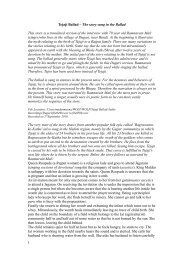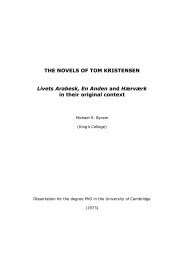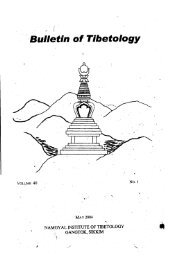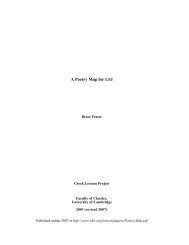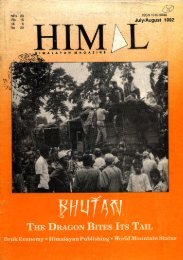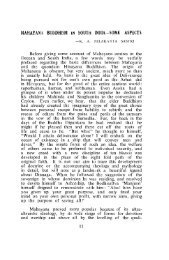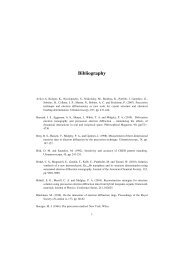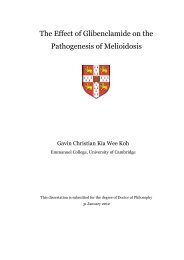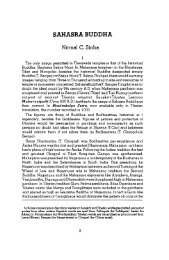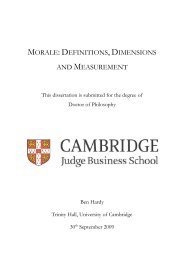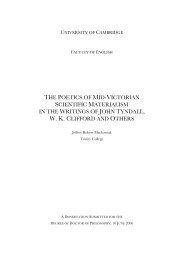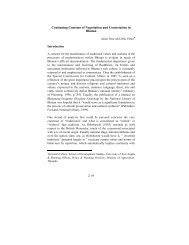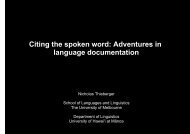The Crusades, the Genoese and the Latin East - DSpace at ...
The Crusades, the Genoese and the Latin East - DSpace at ...
The Crusades, the Genoese and the Latin East - DSpace at ...
Create successful ePaper yourself
Turn your PDF publications into a flip-book with our unique Google optimized e-Paper software.
Monaco 448 Ano<strong>the</strong>r charter from 1192 applied to `universes lanuensibus vel lanuensibus<br />
dictis. '449 However, when Hugh II of Gibelet granted rights to <strong>the</strong> <strong>Genoese</strong>, his definition was<br />
effectively excluding himself <strong>and</strong> <strong>the</strong> <strong>Genoese</strong> inhabitants of Gibelet from this c<strong>at</strong>egory too. This<br />
definition was financially sensible, because Hugh could not possibly allow free commerce to<br />
every <strong>Genoese</strong>, if this applied also to <strong>the</strong> residents of Gibelet.<br />
In an article on `Gli Italiani fuori d'Italia, ' David Abulafia wrote about <strong>the</strong> Italians who<br />
resided outside Italy th<strong>at</strong> <strong>the</strong>y did not necessarily have <strong>the</strong> same commercial interests as <strong>the</strong><br />
Italian inhabitants of <strong>the</strong> mo<strong>the</strong>r-cities. Merchants who settled in such trading communities away<br />
from Italy often developed commercial interests in different directions:<br />
La presenza italiana fuori d'Italia fu cost espressa anche nella costruzione di cittä, nella<br />
formazione di una classe mercantile residente di esp<strong>at</strong>ri<strong>at</strong>i, e nella creazione di reti<br />
commerciali sussidiarie <strong>the</strong> spesso non erano leg<strong>at</strong>e alla cittä madre in Italia, ma<br />
guardavano in direzioni completamente opposte 45°<br />
<strong>The</strong> cre<strong>at</strong>ion of independent societies which sometimes had contradictory interests to<br />
<strong>the</strong>ir home-towns in Italy may not be surprising. However, in <strong>the</strong> crusader st<strong>at</strong>es, <strong>the</strong> Italian<br />
communes have traditionally been viewed as branches of <strong>the</strong>ir home-towns. For example, this<br />
line of thought predomin<strong>at</strong>es in Favreau-Lilie's book, Die Italianer im Heiligen L<strong>and</strong>. In a review<br />
of this monograph, David Abulafia noted this flaw: `Favreau-Lilie has a tendency to speak of<br />
each major Italian city as a monolith with a single interest: <strong>the</strong> fur<strong>the</strong>rance of its Levant trade <strong>at</strong><br />
<strong>the</strong> lowest cost <strong>and</strong> lowest risk. '4s1 <strong>The</strong> meeting between <strong>the</strong> deleg<strong>at</strong>es from Genoa <strong>and</strong> Hugh II in<br />
Gibelet in March 1168, as reflected in <strong>the</strong> charter of Hugh, is clearly a case against this traditional<br />
view. At <strong>the</strong> bottom of <strong>the</strong> charter <strong>the</strong> list of witnesses is split into two parts; <strong>the</strong> names of <strong>the</strong><br />
<strong>Genoese</strong> from Genoa are followed by <strong>the</strong> names of <strong>the</strong> witnesses from Gibelet.<br />
1. Lanfranco Alberico, leg<strong>at</strong>us<br />
lanue<br />
2. marchio Enrico Guercio<br />
3. Iacobo de Sarmaur<br />
4. lacobo de Calam<strong>and</strong>rana<br />
5. Obertus de Oleval<br />
6. Nicola Ebriaco<br />
7. Nicola Belfolio<br />
8. Mantelus<br />
`Et ex Gibelleto adfuerunt'<br />
1. Girardus de Stara<br />
2. Ioffredus de Virnucel<br />
3. Willelmus Leo<br />
4. Nicola<br />
5. Willelmus scriba<br />
"81 Libri Iurium, vol. 1/2, no. 333, p. 142. This concession was granted by King Guy of Lusignan on 26<br />
October 1191<br />
449 Charter by Conrad of Montferr<strong>at</strong> from April 1192.1 Libri lurium, vol. 1/2, no. 334, p. 145.<br />
aso David Abulafia, `Gli Italiani fuori d'Italia', in R. Romano (ed. ), Storia deli'economica italiana, vol. 1<br />
(Turin, 1990), p. 264.<br />
451<br />
David Abulafia, review of Marie-Luise Favreau-Lilie, Die Italianer im Heiligen L<strong>and</strong>, Speculum, 67: 1<br />
(January, 1992), p. 142.<br />
127



